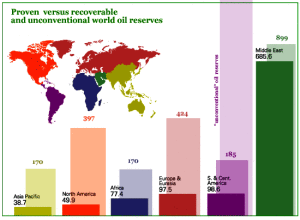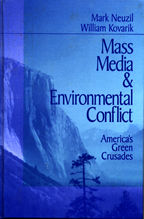By Bill Kovarik
One of the more painful lessons of recent history involves the way money and politics can slant scientific information.
Take the curiously sudden abundance of fossil fuels. Not long ago we had looming shortages, certain oil scarcity, and the supposed need to go to war to protect the lifeblood of the world’s economy.
But now, seemingly out of the blue, we have an abundance of natural gas from fracking, heavy oil from Venezuela and unconventional oil from Canada’s tar sands. And much more conventional to come from the Dakotas, the Arctic, Latin America and the coasts of Africa.
What if the world didn’t need Saudi Arabia any more? What if one of the world’s most brutal and bloodthirsty tyrannies were surplus to modern energy needs?
This is not about replacing oil with solar or wind, although that’s not a bad idea either. This is about replacing Saudi oil with oil from Africa, Asia, Latin America and Canada.
Saudi Oil dominance is based on a trick, which is the idea of a proven oil reserve as the only measure for world oil. This is a useful economic idea but, as many petroleum economists have noted, a very bad yardstick for public policy.
Geologists have known about other kinds of oil reserves for many decades. Along with proven reserves, there are also probable, potential, ultimately recoverable, unconventional, heavy oil, and more.
We usually only count “proven” reserves, although there is far more oil in other categories of reserves in other parts of the world.
Give a thought, for just a minute, to the consequences of this mistaken perspective. The wars over oil. The millions of lives wasted. The trillions of dollars down the military drain. The catastrophic damage to relations between two of the world’s great cultures: Islam and Christianity.
In America and Europe, we were told – over and over again – that two thirds of ALL of the world’s oil was located in the Middle East, and most of that was in Saudi Arabia. We heard this from the press, from the governments and, most of all, from the oil industry.
This categorical misinformation was created by, and for, the world oil industry, and it was distributed with willful ignorance by the US Energy Information Administration and most of the other US governmental agencies, with the exception of the US Geological Survey.
Scientists at USGS had another assessment of world oil released in 2000, although it has disappeared from the USGS web site.
The two charts (above) are a good place to begin. The first was created by BP in 2002, and the big green bar on the right hand side represents Middle Eastern oil reserves. Obviously, it dwarfs the rest of the world. That’s what the oil industry wanted us to believe. Otherwise, sacrificing trillions of dollars and millions of lives in the Middle East wouldn’t have been justified.
The second chart should have been created by the USGS. But it had to be created in 2002 to contrast the BP view with the scientific view in the USGS World Petroleum Assessment and Analysis of Nov. 28, 2000. That world survey was one of a series of surveys that contrasted fairly sharply with the oil industry’s perspective.
The problem was not simply that BP and the rest of the oil industry have had a particular view that slanted to the Middle East. The problem is that this has been the only view available outside specialized circles. The BP annual world oil assessment, and similar reports from Shell and Exxon and the federal Energy Information Administration, never once referred to the USGS. They never let on that there was any question about world oil reserves. They all said that the Middle East had two thirds of the world’s oil. There was no other point of view available.
Of course the USGS could have done something about it. Back in 2005 I asked a high level USGS official why the agency did not inform the media, and he said: “The USGS is not a political agency.” The USGS official didn’t get that question very often because it was widely accepted wisdom that the Middle East had two thirds of all the world’s oil. From Mother Jones to the New York Times to Fox News, from the 1970s to very recently, everyone writing news or dealing with public policy accepted the idea that the world’s supply of future oil would necessarily gravitate around the Middle East. They took it hook, line and sinker.
Peak Oil and the glass of beer
A few years back, Dr. Colin Campell of the Association for the Study of Peak Oil used this analogy:”Understanding [oil] depletion is simple. Think of an Irish pub. The glass starts full and ends empty. There are only so many more drinks to closing time. It’s the same with oil. We have to find the bar before we can drink what’s in it.”
But the analogy of a tankard of beer corresponds to a car’s gas tank. A better analogy to the world oil industry would involve a street full of Irish pubs and a network of warehouses and distilleries. The price keeps going up because the proprietors of your pub claim to be running out of beer. You can see for yourself, they say, the shelf is almost empty. The Ministry for Pubs says its worried and gives each of the pubs a generous depletion allowance and other tax breaks. And the ministry loudly trumpets the promise that it will eventually ease our dependence on beer while quietly cutting alternative beverage research.
Of course, the best kept secret in town is a huge stockpile of barley, yeast and hops in the warehouse across town. If you asked about it in the 1970s or 80s, they’d tell you that it wasn’t “proven” beer. It was only “potential” beer or even “undiscovered” beer. Meanwhile, of course, we have to fight to secure our “proven” sources of beer.
Resource wars and world oil reserves
The logic of the fights over world oil, especially the 1992 and 2003 invasions of Kuwait and Iraq, along with ongoing support for the Saudi tyranny, goes something like this:
Premise 1: The world needs oil. It is the lifeblood of commerce. Premise 2: Two thirds of the world’s oil is in the Middle East. Conclusion: The US has to make sure it is accessible to the world. Even if it means war in the Middle East.
So, if you buy the premise, you buy the conclusion. Few people ever questioned the alternative premise — that there were might be other sources of oil in the world or even alternatives to oil.
Of course, the invasions of Kuwait and Iraq were not officially related to oil reserves. They were officially all about Iraq’s invasion of peaceful Kuwait, or Saddam Hussein’s weapons of mass destruction. But of course it was well understood by anyone paying attention that these were actually resource wars.
In 2007, Federal Reserve Chairman Alan Greenspan said the Iraq War “is largely about oil.” And in the wake of the dismemberment of Jamal Khashoggi in 2018, the Saudi terroerism in Pensacola in 2019, and the ongoing genocidal war in Yemen, we still hear the old myth: Yes, but the world needs Saudi oil.
No. The world does not need Saudi oil, although, it is true, there would need to be a transition phase to shift world oil production away from the blood soaked sands.
What’s a “proven” reserve? Why does it matter?
The embarrassing scientific reality is that petroleum geologists never really thought that the Middle East had two – thirds of all the world’s oil. It was only two thirds of a special category called “proven” oil reserves.
Any geologist will tell you that it’s wrong to focus on “proven” reserves when you consider long-term strategic goals. As Standard Oil geologist Wallace Pratt said in 1944, it is a “fallacy … [to] cite proved reserves as a measure of available future supplies.”
Yet this is exactly what happened. And the fallacy animated US policy in the Middle East for decades. Why?
To begin with, the issue is technical. A “proven” oil reserve is not the opposite of an “unproven” reserve. That’s a false dichotomy, and although it seems natural enough. But it’s quite misleading.
Along with “proven,” the actual technical categories of oil reserves that geologists use include: identified, probable, recoverable, potential, and unconventional. In 2007, industry-affiliated geologists adopted two new categories — contingent resources and prospective resources — to account for anomalies in the old proven reserve system.
Economists, analysts and stock brokers stick to proven reserves because the economics of a proven reserve can be plotted down to the penny. Proven is a category that helps guide investors who need to know just how easy the oil will be to find and what it will take to lift from the ground. They need to know how light and pure the oil is, how much it will cost to refine, how close the oil is to the marketplace. Oil reserves that fall below a standard index of affordability are not called “proven” reserves under Securities and Exchange Commission rules, and they are not developed because no one wants to lose the money it would take to develop them. Probable reserves are often well characterized by seismic tests and sample drilling. They are just pennies away from a competitive position in the oil market.
Conventional wisdom has it that investments are based on the world’s proven oil reserves. But it is probably more accurate to say that oil company investments and friendly country policies are what make oil reserves “proven.”
Proven reserves can be remarkably elastic over time. Geologist M.A. Adelman noted n his book The Genie out of the Bottle that a special WWII mission to Persian Gulf estimated Saudi Arabia’s oil reserves at 16 billion proved and 5 billion probable. This was 1944. Thirty years later, those same fields were estimated at 42 and 74 billion. In 1984, geologists estimated another 199 billion barrels of probable reserves in the Gulf region. Today the proven reserve figure is about 268 billion according to OPEC, BP and the US Energy “Information” Agency.e .
For the entire Middle East, the proven reserve figures are around 650 billion barrels, or about two-thirds of a world total of around one trillion. But petroleum geologists have long known this is far too “conservative” an estimate, and too heavily slanted to the Middle East.
There is no doubt that the traditional hostility between Latin American nations and the once-US based oil industry had been a factor holding back oil reserve estimates in Venezuela and Mexico. Nor is there any doubt that the under-counted Latin American reserves would have upset OPEC production quotas if they had suddenly been counted in the 1980s and 90s.
So by using the economic definition of an oil reserve, as opposed to the scientific definition, the oil industry in effect pulled a slight of hand and reset the premise of the world geo-strategic energy debate. No doubt it was misleading, and intentionally so. All too often, even the word proven was dropped from most news articles and government agency reports about world oil reserves. So people naturally thought that the Middle East had two thirds of ALL the world’s oil, and nobody in government or the oil industry took it upon themselves to challenge that notion.
The usual explanation, repeated in this Wikipedia article, is that “the total amount of unconventional oil resources in the world considerably exceeds the amount of conventional oil reserves, but are much more difficult and expensive to develop.”
How “much more” expensive? Is it so much more that the reserves can’t be counted? But the fact is that Canadian and Venezuelan tar sands and heavy oils require a fraction of the total sale price to upgrade and ship from remote locations. The amount can be significant in a volatile market. But it is in the neighborhood of 15 to 30 percent at most.
So now we have the information equivalent of a Fukushima or Chernobyl. We now know the vast extent of the Marcellus Shale gas reserves and the Canadian oil sands and the Arctic reserves. We now know that there were trillions and trillions of barrels of oil in the geosynclinal trough from the Orinoco River to the Falkland Islands.
Imagine if we had known that in the 1980s and 90s. The sad thing is, we did. Or at least, the scientists did. And we know it today, yet still we labor under the old Saudi oil myth, turning a blind eye to 911, to the Iraq invasion, to the genocide in Yemen, to the Khashoggi killing, and now, to the Pensacola massacre.
========================================
Personal note:
I first heard about the massive oil reserves in Canada and Latin America, which are far bigger than the Middle East, while I worked in Washington in the trade press. I covered energy and environment for the Business Publishers as the editor of Energy Resources and Technology and Latin American Energy Report.
During a presentation put on by a Washington “think-tank,” I met a group of geologists who were concerned that the facts were not on the table. Dr. Bernardo Grossling of the USGS was among them, and there were a number of others who were there to argue that there would be no need for military intervention to keep open the Strait of Hormuz.
Alirio Parra, then head of Petroleos de Venezuela, spoke at the same meeting. I’ll never forget the shock when he announced that the fabled heavy oil field in the Orinoco region had at least three to four trillion (yes, Trillion with a T) barrels of oil, and that there was far more in an oil field stretched down the eastern slope of the Andes Mountains all the way to Argentina.
Grossling testified on the Hill several times about the abundance of oil in Latin America, but few if any in the press reported it, mostly because there was so much contrary information being churned out of the new Energy Department and the oil industry.
A few weeks after the panel I ran into energy expert Dan Yergin on the floor of the American Stock Exchange in New York. I asked what he thought of all this and he said what everyone in the oil industry was saying: It’s not really oil, it’s too expensive to make it into oil, and the future is in the Middle East. A decade later he confirmed this with his book The Prize. It even won a Pulitzer.
But I was never convinced that the Middle East was “The Prize.” Heavy oil only takes an extra 50 cents to one dollar to upgrade, and the costs were coming down.
I wrote about the “proven reserve problem” for my publication, Energy Resources and Technology, and kept writing about it. I wrote about it in the Baltimore Sun for the 10th anniversary of the 1979 Iranian oil crisis. I wrote about it online for the 20th anniversary. And the 30th.
My take on it is not so much that Peak Oil is a fallacy — I wish it were not, because I sympathize more with people who would like to see more energy conservation. We probably will run out of oil some day, although it may be far too late given the climate crisis.
My professional concern is the extent to which the oil industry can set the terms of national debate and guide political and social capital along the path that favors them economically, no matter what the cost in terms of wasted lives, wounded soldiers, or squandered taxes.
It seems, after all, we wrecked Iraq and militarized the Persian Gulf just because oil there was cheaper, not because it was the only source of oil.
My concern is how little we understand about blowback and what happens to people and institutions who insist on creating and imposing their own information environments.
———-
More info: In 2002 – 2003 I wrote The Oil Reserve Fallacy. It has many sources and links in this area.
Also see the recent “Golden Age of Oil that Wasn’t” and the Grist magazine article, “What if we never run out of oil?“



 Revolutions in Communication
Revolutions in Communication Mass Media & Environmental Conflict
Mass Media & Environmental Conflict